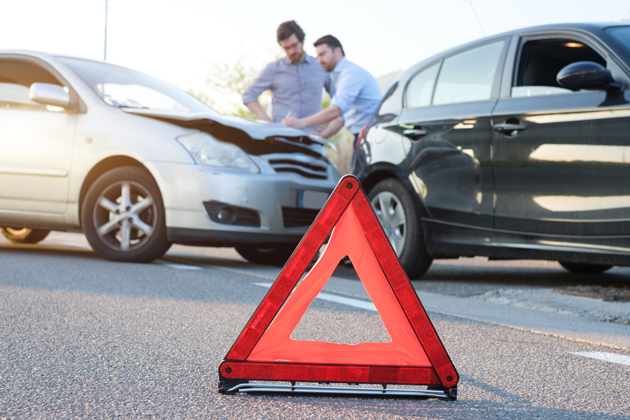
Robert is the staff accountant for ABC Construction. Occasionally, he runs errands for the company using his own car. On such an errand, Robert was looking down to check a text he had just received when he rolled through a red light and rammed into a brand-new S-Class Mercedes sedan driven by a mom (Christine) who had her three kids with her. Fortunately, no one was killed, but all four were seriously injured. The Mercedes was totaled. Christine bore the brunt of the impact and sustained a broken arm, fractured pelvis and severe head injuries. The damages will likely be hundreds of thousands of dollars and possibly millions. About a week after the accident, Bill McKenzie, owner of ABC was served with a law suit brought by Christine’s family. It asked for $10 million in damages for the injuries suffered by family members and damage to the Mercedes. Bill was shocked. “It’s not even my car! How could I possibly be responsible?”
Insurance follows the vehicle and the owner of the vehicle is primarily responsible regardless of who is driving the car. Robert has insurance and his limits are 100/300/50, meaning limits of $100,000 for injuries sustained by any one person, $300,000 total for all the people injured, and $50,000 for property damage. In California, where the accident occurred, the minimum required insurance limits are 15/30/5. In this case, Robert’s insurer, realizing that Robert was clearly at fault and wanting to avoid the costs of litigation (which the insurer would have to pay in addition to their limits), simply offered up the policy limits. $300,000 would not come close to paying the families medical bills and $50,000 was about half the value of the damaged Mercedes.
The question still stands, “Why did ABC get sued? Could they be responsible?” Robert was on an errand for his employer. ABC benefitted from Robert using his vehicle on their behalf. Because of this, ABC has vicarious responsibility for liability arising out of Robert’s use of his own car on their business. Robert’s insurance may be primary but, in this instance, his limits are not adequate to pay for the damages he caused. After being served, Bill called his insurance broker to find out if he was covered and was told that he was.
This was because ABC Construction has a primary auto policy with $1 million in limits. They have a $10 million excess policy on top of that giving them total limits of $11 million. Fortunately, ABC’s auto policy provides coverage for “all autos.” This includes owned, hired and “non-owned” automobiles. Robert’s vehicle comes under the definition of a “non-owned auto.”
The Insurance Services Office (ISO) standard auto policy defines “non-owned auto” as: "Only those 'autos' you do not own, lease, hire, rent or borrow that are used in connection with your business. This includes "autos" owned by your 'employees,' partners (if you are a partnership), members (if you are a limited liability company) or members of their households but only while used in your business or your personal affairs."
Many organizations have controls in place to reduce the frequency and severity of accidents arising out of their fleet. However, vehicles used on company business that are owned by their employees are often overlooked. In addition to purchasing non-owned auto insurance, the following are some best practices for managing this risk:
- Identify anyone in your company who may drive their vehicle on company business. This includes employees, interns, volunteers and others.
- Run motor vehicle reports (MVR’s) on all drivers and only allow those with acceptable driving records to drive on company business. Allowing unlicensed employees or employees with poor driving records to operate vehicles for your organization can increase your liability exposure. Drivers with records showing moving violations and/or preventable accidents or any major/serious violations (e.g., driving while impaired, reckless/careless driving, driving with a suspended license, etc.) should be vetted to determine if their driving records warrant prohibiting them from driving on your organization's behalf. Have an MVR policy in place that outlines how often MVRs are reviewed, your organization's standards for moving violations and accidents, and what actions may be taken if a driver's record is not acceptable. Review MVRs at least annually.
- Require anyone operating their vehicle on company business to maintain a minimum level of personal insurance. The limit you require and whether or not you audit compliance is up to you.
- Make certain anyone who may drive on behalf of the company understands your corporate rules when it comes to driving any vehicle. This includes but is not limited to abiding by all laws, cell phone rules and other regulations.
- Consider enrolling those employees who regularly drive their own vehicles on the company’s behalf in any of the safe driving courses you require your employees who drive your corporately owned vehicles to enroll in.
- Make sure your corporate auto policy addresses an employee’s use of their personal automobiles. Subject to an HR and legal review, it might read: When it is necessary for a staff member to use his/her own vehicle for business travel, mileage will be reimbursed by the firm at the current IRS rate. Use of personal vehicles for business travel is to be approved by the employee's supervisor. It is the supervisor’s responsibility to ensure that the staff member driving on company business has a valid driver’s license, an acceptable driving record and proof of insurance on his/her automobile. Any employee using his/her automobile on behalf of the company should carry minimum bodily injury limits of $250,000 each person, $500,000 each accident and property damage limits of $100,000 each accident. A $500,000 combined single limit will also satisfy this requirement. Please note that the company does not provide any liability coverage for you. In addition, if you are involved in an accident, the company does not provide any physical damage coverage for your automobile. You must look to your own insurance company for this coverage.
